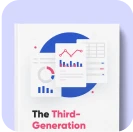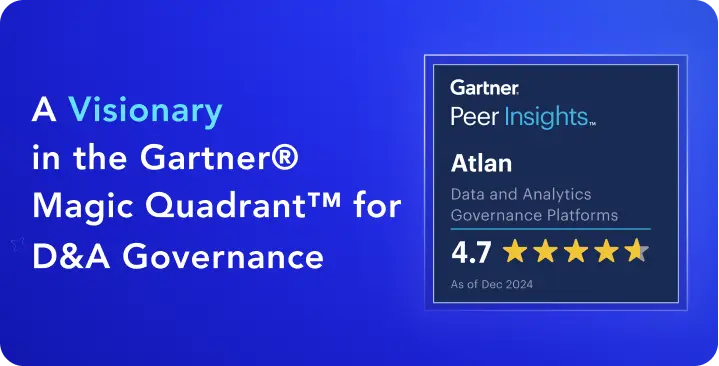Data Migration in Financial Services: Your Complete 2025 Guide
Share this article
Data migration in financial services is a strategic initiative that enhances operational efficiency, strengthens analytics capabilities, and ensures regulatory compliance.
Finserv enterprises have evolved beyond traditional boundaries into areas like DeFi, P2P payments, and financial wellness. Migrating to cloud-native platforms fuels innovation and supports new architectural approaches like data mesh to enhance operational efficiency.
See How Atlan Simplifies AI Governance ✨ – Start Product Tour
Yet, the complexities of legacy infrastructure, stringent regulations, and fragmented data environments make migration challenging. Let’s explore how financial services companies can tackle data migration concerns and challenges to unlock revenue, bolster security, and improve customer experiences.
Table of Contents #
- What is data migration in financial services?
- Data migration in financial services: Top trends driving companies toward data migration
- The business benefits of data migration in financial services
- Top challenges of data migration in financial services
- Data migration in financial services: Best practices to mitigate risks
- Data migration in financial services: How embedded governance can help
- Summing up
- Data migration in financial services: Related reads
What is data migration in financial services? #
Data migration in financial services refers to the systematic transfer of structured and unstructured data between environments, ensuring continuity, accuracy, and compliance. Its primary objectives are operational transformation, enabling advanced analytics, and fostering seamless compliance with financial regulations.
“Migrating core finance processes (for example, general ledger, accounts payable and accounts receivable) has significant transactional and reporting impacts on an enterprise.” - Gartner
Transitioning to cloud-based platforms improves scalability and cost-efficiency, whereas consolidating your data estate under one roof improves analytics and streamlines operations. With 91% of financial service executives seeing cloud-first infrastructure as important for growth, cloud data migration in finserv is a strategic priority for driving innovation.
Data migration in financial services: Top trends driving companies toward data migration #
Modern financial services are moving to agile, cloud-native infrastructure–flexible architectures like data mesh–to support rapid innovation and scale, cut costs, and improve compliance.
Several key trends are shaping this shift:
- Cloud-first strategy: Cloud-native solutions enable real-time data processing, cost efficiency, and support automation and AI.
- Data consolidation: Migrating fragmented legacy systems improves interoperability, risk management, and decision-making. It also brings all metadata under one roof, which is the first step toward ensuring AI-readiness of your data estate.
- AI & ML adoption: Financial institutions increasingly leverage AI to transform everything from risk assessment to customer experience. Take London-based startup ComplyAdvantage, for instance, which recently built an internal AI platform to help identify and track individuals or entities involved in financial crime. AI-driven analytics demand clean, well-governed data, which requires a modern, cloud-native data architecture.
- Evolving regulatory landscape: The financial sector faces intensifying regulatory scrutiny, particularly with the SEC’s new cybersecurity disclosure requirements and the EU’s DORA regulation coming into effect. These require a secure, audit-ready data estate and data migration would facilitate centralized data management, compliance workflow automation, and real-time monitoring of data access and usage.
The business benefits of data migration in financial services #
The top benefits of data migration for financial services enterprises include:
- Cost optimization: Cloud-based migrations reduce infrastructure costs by minimizing on-premise dependencies. A McKinsey report states that cloud adoption in financial institutions can reduce operational costs by up to 30%.
- Enhanced customer experience: By integrating customer data, financial firms can deliver personalized services. Cloud migration is a crucial enabler of a unified data strategy, as it centralizes disparate data sources, enhances accessibility, and ensures seamless governance.
- Operational efficiency: Automation in data workflows reduces human intervention, saving time and reducing errors. For example, Commonwealth Financial Network, a leading broker/dealer in financial services, leveraged Atlan’s automation capabilities to streamline its workflows. By automating critical data processes and embedding governance, this approach accelerated time-to-value and improved regulatory compliance.
Top challenges of data migration in financial services #
Consider the hypothetical journey of PayFlow, a rapidly growing payment gateway processing millions of transactions daily.
PayFlow’s journey to modernize its data infrastructure brought them face-to-face with the following challenges of data migration, which are commonly faced by finserv enterprises:
- Data complexity and a fragmented data estate
- Transitioning from legacy systems
- Downtime risks
- Regulatory requirements
Data complexity and a fragmented data estate #
Like many finserv organizations, PayFlow operated in silos, with different teams maintaining their own data systems and standards. This led to inconsistent data formats, definitions, and governance practices. This fragmentation, combined with the sheer volume and velocity of transactional data, made migration complex.
When transitioning its transaction analytics system, PayFlow discovered that its merchant APIs were incompatible with the new cloud architecture. Legacy batch processing couldn’t support the real-time synchronization required for instant fraud detection and merchant insights. Additionally, ensuring data accuracy and integrity across multiple sources became a challenge, as discrepancies in data quality and lineage threatened seamless integration.
Transitioning from legacy systems #
A successful financial data migration depends on maintaining context, compliance, and continuity—especially when transitioning from legacy systems.
For PayFlow, the most complex challenge was extracting and transforming data from outdated infrastructure that wasn’t built for modern cloud environments. Legacy systems stored data in rigid formats, making it difficult to migrate without extensive reformatting and validation.
There was also a lack of clarity around data ownership and dependencies within the ecosystem, resulting in a constant risk of errors and even data corruption.
Even after migration, integrating the data into cloud-native applications required custom workflows to compensate for outdated architectures.
Downtime risks #
One of the biggest risks in financial data migration is system downtime, which can disrupt critical operations such as transaction processing, customer account access, and real-time risk monitoring.
For PayFlow, ensuring uninterrupted services during its migration was a major challenge. Since its legacy infrastructure handled high transaction volumes, any disruption could result in delayed settlements, failed payments, and customer dissatisfaction.
Regulatory requirements #
Midway through its migration, PayFlow encountered revised CCPA and GDPR compliance requirements that impacted how it handled and stored payment data. The updated regulations introduced stricter data retention policies and customer data access rights, requiring adjustments to the company’s cloud data architecture.
As compliance concerns grew, internal resistance surfaced. Some executives, wary of sunk costs, questioned the decision to move away from their heavily customized on-prem legacy systems that had been deeply integrated into PayFlow’s operations.
To move forward, PayFlow had to reassess its migration roadmap and ensure that its new cloud infrastructure met updated regulatory standards without compromising business continuity.
Data migration in financial services: Best practices to mitigate risks #
Let’s now lay out some key takeaways derived from PayFlow’s typically bumpy data migration journey:
- Maintain data consistency and integrity: Standardizing data formats, definitions, and governance practices is crucial for transforming a siloed data estate. Automated data validation, lineage tracking, and real-time reconciliation can help resolve inconsistencies across multiple data sources, ensuring accuracy and integrity in cloud environments.
- Enhancing security and compliance: Strengthening security involves dynamic access controls to restrict data exposure, AI-powered threat detection to identify unauthorized access attempts, and compliance automation for audit trails and regulatory tracking. Financial institutions must also proactively monitor regulatory updates and incorporate compliance automation into their cloud infrastructure.
- Safeguarding data privacy: Safeguarding sensitive information requires dynamic data masking during testing, ensuring privacy while allowing realistic test scenarios. Meanwhile, end-to-end encryption protects data at every stage, both in transit and at rest, reducing the risk of breaches or unauthorized access.
- Ensuring business continuity: Ensuring business continuity requires phased migration strategies, backup environments, and rollback mechanisms. Finserv organizations must adopt real-time failover systems and parallel run testing to minimize disruptions to transaction processing and customer services.
Data migration in financial services: How embedded governance can help #
According to Forrester, "successful [data governance] platforms provide a single pane of glass for metadata management across diverse data ecosystems.” That’s where embedded data governance is crucial.
Embedded data governance integrates governance directly into the daily workflows of data and metadata users, enabling them to access trusted, well-documented data without interrupting their work. It shifts governance from a top-down compliance task to a collaborative, user-first approach.
As a result, embedded data governance ensures effective data migration in financial services while maintaining context, compliance, and continuity throughout the journey.
A platform that embeds data governance into every workflow would provide a “single pane of glass” for managing metadata across diverse data ecosystems. This ensures consistent governance practices, better collaboration, and trust in data across an organization.
Atlan’s unified control plane emulates this pane of glass. It automates metadata discovery, enforces governance rules, and tracks active data lineage, enabling finserv companies to navigate migration complexity and unlock long-term value.
Here’s a breakdown of how Atlan’s control plane can streamline data migration for finserv organizations:
- Automated metadata discovery: Auto-ingest metadata and classify data assets with the right tags, access policies, and context.
- Column-level, automated, cross-system lineage tracking: Automatically map relationships between data assets across legacy and modern systems while maintaining data flow logs. Automated data lineage also helps propagate tags, classifications, and access roles.
- Enhanced data context: By enriching data with business context, Atlan’s integrated metadata layer enables more informed decision-making and easier traceability.
- Active, AI-assisted data governance: Enforce consistent policies across systems with automated rules, ensuring data security, privacy, integrity, and compliance throughout the migration journey.
- Metadata lake house approach: Create a unified view of the data ecosystem for end-to-end visibility of your entire data estate.
- Real-time data monitoring: Get real-time alerts in scenarios where data fails quality checks or an issue is found in relation to a specific policy’s coverage.
- Automated risk and compliance management: Intelligent automation continuously monitors data flows, classifies sensitive information, and enforces regulatory policies in real time, reducing manual intervention.
Also, read → The unified control plane in action
Summing up #
Data migration in financial services is a critical step toward modernizing infrastructure, strengthening compliance, and ensuring secure, high-quality data. A structured approach—supported by effective data governance, automation, AI, and cloud-native architectures—helps mitigate risks and streamline the transition.
As financial institutions adapt to evolving regulations, security threats, and AI-driven innovation, well-planned data migration is vital for long-term scalability, business continuity, growth, and innovation.
Data migration in financial services: Related reads #
- Benefits of Moving from On-Premise to Cloud
- Data Migration: On-Premise to Cloud - 10 Steps to Success
- 8 Essential Strategies to Fast-Track Your Cloud Migration Journey
- Cloud vs On-Premise vs Hybrid: Choosing the Right Data Management Approach
- Data Migration in Banking: A Complete Guide
- What is Data Governance? Its Importance, Principles & How to Get Started?
- Data Governance and Compliance: An Act of Checks & Balances
- Data Governance and GDPR: A Comprehensive Guide to Achieving Regulatory Compliance
- Role of Data Catalog in Data Security: Why It Matters
- Data Compliance Management in 2025
- Financial Data Governance: Strategies, Trends, Best Practices
- Data Governance Policy: Examples, Templates & How to Write One
- Automated Data Governance: How Does It Help You Manage Access, Security & More at Scale?
Share this article











